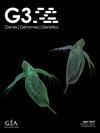单倍型分辨、染色体规模的 Malus domestica Borkh.WA 38
IF 2.1
3区 生物学
Q3 GENETICS & HEREDITY
引用次数: 0
摘要
对农业具有重要意义的蔷薇科作物的基因组测序在完整性和注释质量方面都取得了快速进展。全基因组测序和注释为育种者、研究人员和种植者提供了有关果实品质和抗病性等栽培品种特定性状的信息,并为加强采后贮藏的策略提供了依据。在此,我们展示了Malus domestica, 'WA 38'的染色体级单倍型基因组,这是2017年作为Cosmic Crisp®投放市场的一个新的苹果栽培品种。利用基于 k-mer 方法的长短读测序数据,对源自每个亲本的染色体进行了组装和分离。这是首个完全按亲本单倍型分期的梨果基因组,其中每个亲本的染色体都被识别并分离成各自独特的单倍体。这两个单倍组的集合,即源自 "Honeycrisp "的 HapA 和源自 "Enterprise "的 HapB,各有约 650 兆字节,两者的 BUSCO 得分均为 98.7%。来自 HapA 和 HapB 的注释基因分别为 53028 和 54235 个。此外,我们还提供了与 "Gala"、"Honeycrisp "和其他相关栽培品种的基因组规模比较,突出显示了基因组结构和基因家族包络的主要差异。这项组装和注释工作是与美国校园树木基因组项目(American Campus Tree Genomes project)合作完成的,该项目包括'WA 38'(华盛顿州立大学)、'd'Anjou'梨(奥本大学)等。为了确保透明度、可重复性和对任何基因组项目的适用性,我们的基因组组装和注释工作流程都有详细记录,并在公共 GitLab 存储库中共享。所有软件都是容器化的,可以简单地实现工作流程。本文章由计算机程序翻译,如有差异,请以英文原文为准。
A Haplotype-resolved, Chromosome-scale Genome for Malus domestica Borkh. ‘WA 38’
Genome sequencing for agriculturally important Rosaceous crops has made rapid progress both in completeness and annotation quality. Whole genome sequence and annotation gives breeders, researchers, and growers information about cultivar specific traits such as fruit quality and disease resistance, and informs strategies to enhance postharvest storage. Here we present a haplotype-phased, chromosomal level genome of Malus domestica, ‘WA 38’, a new apple cultivar released to market in 2017 as Cosmic Crisp®. Using both short and long read sequencing data with a k-mer based approach, chromosomes originating from each parent were assembled and segregated. This is the first pome fruit genome fully phased into parental haplotypes in which chromosomes from each parent are identified and separated into their unique, respective haplomes. The two haplome assemblies, ‘Honeycrisp’ originated HapA and ‘Enterprise’ originated HapB, are about 650 Megabases each, and both have a BUSCO score of 98.7% complete. A total of 53,028 and 54,235 genes were annotated from HapA and HapB, respectively. Additionally, we provide genome-scale comparisons to ‘Gala’, ‘Honeycrisp’, and other relevant cultivars highlighting major differences in genome structure and gene family circumscription. This assembly and annotation was done in collaboration with the American Campus Tree Genomes project that includes ‘WA 38’ (Washington State University), ‘d’Anjou’ pear (Auburn University), and many more. To ensure transparency, reproducibility, and applicability for any genome project, our genome assembly and annotation workflow is recorded in detail and shared under a public GitLab repository. All software is containerized, offering a simple implementation of the workflow.
求助全文
通过发布文献求助,成功后即可免费获取论文全文。
去求助
来源期刊

G3: Genes|Genomes|Genetics
GENETICS & HEREDITY-
CiteScore
5.10
自引率
3.80%
发文量
305
审稿时长
3-8 weeks
期刊介绍:
G3: Genes, Genomes, Genetics provides a forum for the publication of high‐quality foundational research, particularly research that generates useful genetic and genomic information such as genome maps, single gene studies, genome‐wide association and QTL studies, as well as genome reports, mutant screens, and advances in methods and technology. The Editorial Board of G3 believes that rapid dissemination of these data is the necessary foundation for analysis that leads to mechanistic insights.
G3, published by the Genetics Society of America, meets the critical and growing need of the genetics community for rapid review and publication of important results in all areas of genetics. G3 offers the opportunity to publish the puzzling finding or to present unpublished results that may not have been submitted for review and publication due to a perceived lack of a potential high-impact finding. G3 has earned the DOAJ Seal, which is a mark of certification for open access journals, awarded by DOAJ to journals that achieve a high level of openness, adhere to Best Practice and high publishing standards.
 求助内容:
求助内容: 应助结果提醒方式:
应助结果提醒方式:


